Kenwood VR-6070 User Manual

AUDIO VIDEO SURROUND RECEIVER
VR-7060
INSTRUCTION MANUAL
KENWOOD CORPORATION
About the supplied remote control
Compared to standard remote controls, the remote control supplied with this receiver has several operation modes. These modes enable the remote control to control other audio/video components. In order to effectively use the remote control it is important to read the operating instructions and obtain a proper understanding of the remote control and how to switch its operation modes (etc.).
Using the remote control without completely understanding its design and how to switch the operation modes may result in incorrect operations.
B60-5346-00 00 MA (K, P) |
0209 |
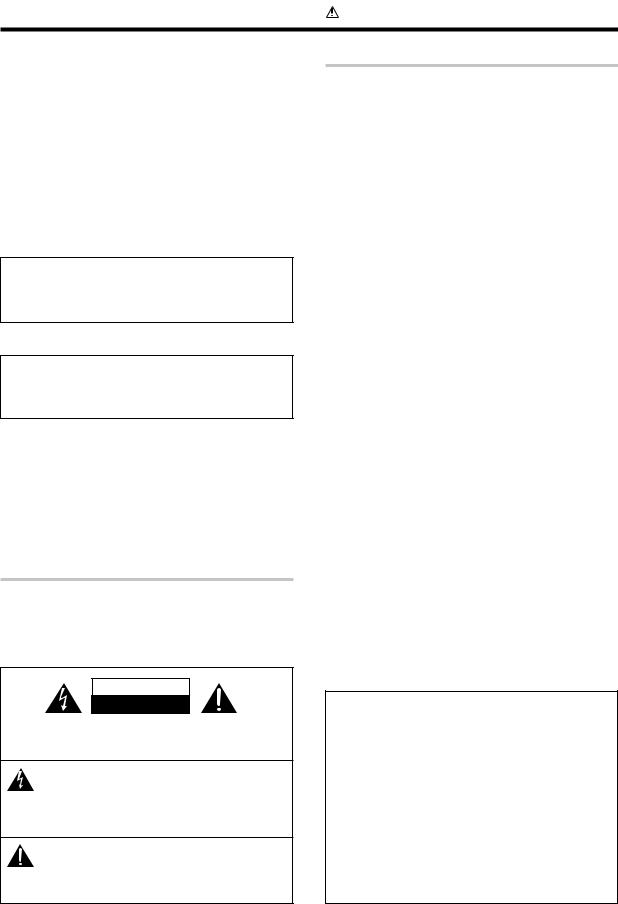
Before applying the power
Caution : Read this page carefully to ensure safe operation.
Units are designed for operation as follows.
U.S.A. and Canada |
........................................... AC 120 V only |
Australia ........................................................... |
AC 240 V only |
Europe and U.K ................................................ |
AC 230 V only |
China and Russia ............................................. |
AC 220 V only |
Other countries .......... |
AC 110 - 120 / 220 - 240 V switchable* |
How to use this manual
This manual is divided into four sections, Preparations, Operations, Remote Control, and Additional Information.
Preparations
Shows you how to connect your audio and video components to the receiver and prepare the surround processor.
Since this receiver works with all your audio and video components, we will guide you in setting up your system to be as easy as possible.
Maintenance of the unit
When the front panel or case becomes dirty, wipe with a soft, dry cloth. Do not use thinner, benzine, alcohol, etc. for these agents may cause discoloration.
In regard to contact cleaner
Do not use contact cleaners because it could cause a malfunction. Be specially careful not to use contact cleaners containing oil, for they may deform the plastic component.
Operations
Shows you how to operate the various functions available on the receiver.
Remote Control
Shows you how to operate other components using the remote control, as well as a detailed explanation of all remote control operations. Once you have registered your components with the proper setup codes, you’ll be able to operate both this receiver and your other AV components (TV, VCR, DVD player, CD player, etc.) using the remote control supplied with this receiver.
Additional Information
Shows you additional information such as “In case of difficulty” (troubleshooting) and “Specifications”.
Safety precautions
WARNING :
TO PREVENT FIRE OR ELECTRIC SHOCK, DO NOT EXPOSE THIS APPLIANCE TO RAIN OR MOISTURE.
CAUTION
RISK OF ELECTRIC SHOCK
DO NOT OPEN
CAUTION: TO REDUCE THE RISK OF ELECTRIC SHOCK, DO NOT REMOVE COVER (OR BACK). NO USER-SERVICEABLE PARTS INSIDE. REFER SERVICING TO QUALIFIED SERVICE PERSONNEL.
THE LIGHTNING FLASH WITH ARROWHEAD SYMBOL, WITHIN AN EQUILATERAL TRIANGLE, IS INTENDED TO ALERT THE USER TO THE PRESENCE OF UNINSULATED “DANGEROUS VOLTAGE” WITHIN THE PRODUCT’S ENCLOSURE THAT MAY BE OF SUFFICIENT MAGNITUDE TO CONSTITUTE A RISK OF ELECTRIC SHOCK TO PERSONS.
THE EXCLAMATION POINT WITHIN AN EQUILATERAL TRIANGLE IS INTENDED TO ALERT THE USER TO THE PRESENCE OF IMPORTANT OPERATING AND MAINTENANCE (SERVICING) INSTRUCTIONS IN THE LITERATURE ACCOMPANYING THE APPLIANCE.
Memory back up function
Please note that the following items will be deleted from the unit's memory if the power cord is disconnected from the AC outlet for approximately 1 day.
• Power mode. |
• Distance setting. |
• Input selector settings. |
• Input mode setting. |
• Picture output. |
• Midnight mode setting. |
• Speaker ON/OFF. |
• PRO LOGIC II mode setting. |
• Volume level. |
• CS II mode setting. |
• BASS, TREBLE, INPUT level. |
• Broadcast band. |
• TONE ON/OFF. |
• Frequency setting. |
• LOUDNESS ON/OFF. |
• Preset stations. |
• Dimmer level. |
• Tuning mode. |
• MD/TAPE settings. |
• DSP mode. |
• Listen mode setting. |
• ACTIVE EQ mode. |
• Speaker settings. |
• SPEAKER EQ mode. |
• SW RE-MIX ON/OFF. |
|
2 EN
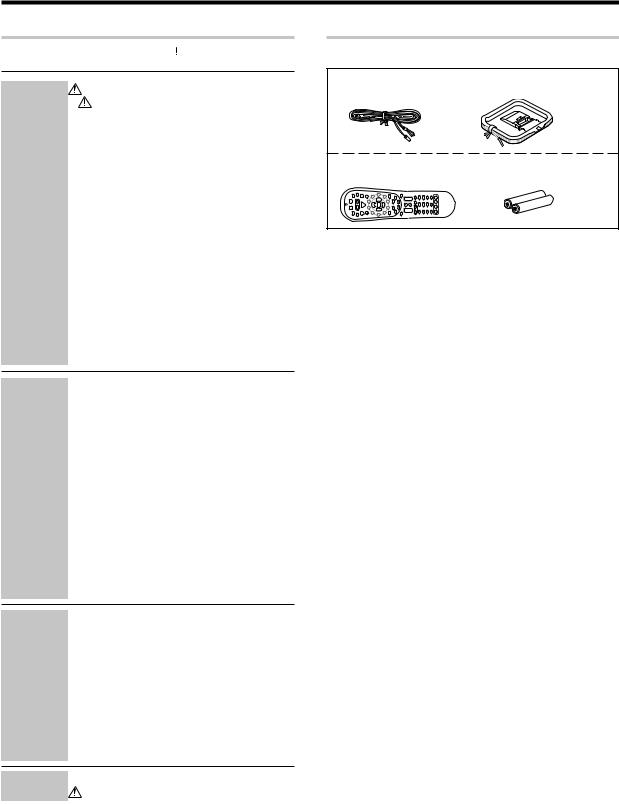
Before applying the power
Contents
Caution : Read the pages marked  carefully to ensure safe operation.
carefully to ensure safe operation.
|
Before applying the power .............................. |
2 |
|
Safety precautions ............................................. |
2 |
|
How to use this manual ..................................... |
2 |
|
Unpacking .......................................................... |
3 |
|
Preparing the remote control ............................ |
4 |
|
Special features ................................................. |
5 |
|
Names and functions of parts ......................... |
6 |
|
Main Unit ........................................................... |
6 |
|
Remote control unit ............................................... |
7 |
|
Setting up the system ........................................ |
8 |
|
Connecting the terminals .................................. |
9 |
Preparations |
|
|
|
Connecting audio components ........................ |
10 |
|
Connecting video components ........................ |
11 |
|
Digital connections .......................................... |
12 |
|
Connecting video components |
|
|
(COMPONENT VIDEO) .................................... |
13 |
|
Connecting a DVD player (6-channel input) ..... |
14 |
|
Connecting the speakers ................................. |
15 |
|
Connecting to the AV AUX jacks ..................... |
16 |
|
Connecting the antennas ................................. |
16 |
|
Connecting the system control ....................... |
17 |
|
Preparing for surround sound ....................... |
18 |
|
Speaker settings .............................................. |
18 |
|
Normal playback .............................................. |
20 |
|
Preparing for playback ..................................... |
20 |
|
Listening to a source component .................... |
21 |
|
Adjusting the sound ......................................... |
21 |
|
Recording .......................................................... |
23 |
|
Recording audio (analog sources) ................... |
23 |
|
Recording video ............................................... |
23 |
|
Recording audio (digital sources) .................... |
23 |
Operations |
Listening to radio broadcasts ....................... |
24 |
|
Tuning radio stations ....................................... |
24 |
|
Presetting radio stations manually .................. |
24 |
|
Receiving preset stations ................................ |
25 |
|
Receiving preset stations in order (P.CALL) ... |
25 |
|
Ambience effects ............................................. |
26 |
|
Surround modes .............................................. |
26 |
|
Surround play ................................................... |
29 |
|
DVD 6-channel playback .................................. |
30 |
|
Convenient functions ....................................... |
30 |
|
Basic remote control operations for other |
|
|
components ....................................................... |
33 |
|
Registering setup codes for other |
|
|
components ..................................................... |
33 |
|
Searching for your code ................................... |
33 |
Remote Control |
Checking the codes ......................................... |
34 |
|
Re-assigning device keys ................................ |
34 |
|
Operating other components .......................... |
34 |
|
Setup code chart .............................................. |
35 |
|
CASSETTE deck, CD player & MD recorder |
|
|
operations ........................................................ |
39 |
|
Other components’ operations ....................... |
40 |
Additional |
In case of difficulty .......................................... |
42 |
Information |
Specifications .................................................. |
44 |
Unpacking
Unpack the unit carefully and make sure that all accessories are present.
FM indoor antenna (1) |
AM loop antenna (1) |
Remote control unit (1) |
Batteries (R6/AA) (2) |
RC-R0822 |
|
If any acccessories are missing, or if the unit is damaged or fails to operate, notify your dealer immediately. If the unit was shipped to you directly, notify your shipper immediately. Kenwood recommends that you retain the original carton and packing materials in case you need to move or ship the unit in the future.
Keep this manual handy for future reference.
3 EN
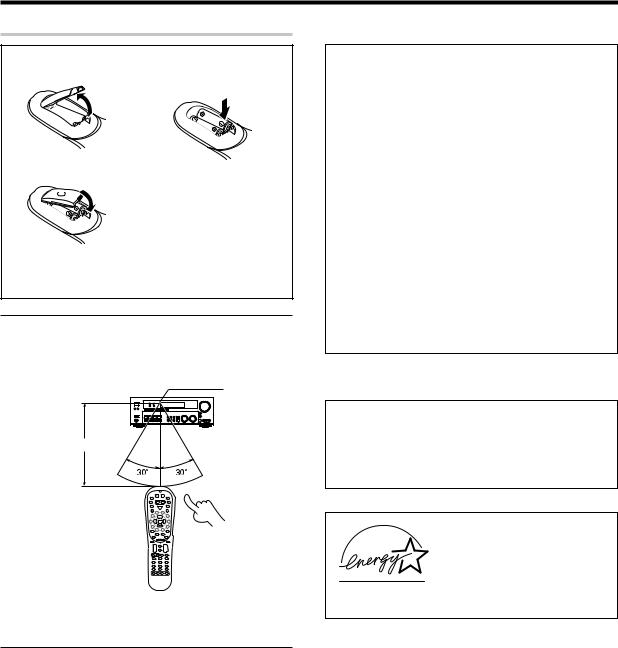
Before applying the power
Preparing the remote control
Loading the batteries
1 Remove the cover. |
2 Insert the batteries. |
3 Close the cover.
•Insert two AA-size (R6) batteries as indicated by the polarity markings.
Operation
When the STANDBY indicator is lit, the power turns ON when you press the POWER RCVR key on the remote control. When the power comes ON, press the key you want to operate.
For the U.S.A.
FCC WARNING
This equipment may generate or use radio frequency energy. Changes or modifications to this equipment may cause harmful interference unless the modifications are expressly approved in the instruction manual. The user could lose the authority to operate this equipment if an unauthorized change or modification is made.
NOTE:
This equipment has been tested and found to comply with the limits for a Class B digital device, pursuant to Part 15 of the FCC Rules. These limits are designed to provide reasonable protection against harmful interference in a residential installation. This equipment may cause harmful interference to radio communications, if it is not installed and used in accordance with the instructions. However, there is no guarantee that interference will not occur in a particular installation. If this equipment does cause harmful interference to radio or television reception, which can be determined by turning the equipment off and on, the user is encouraged to try to correct the interference by one or more of the following measures:
–– Reorient or relocate the receiving antenna.
–– Increase the separation between the equipment and receiver.
–– Connect the equipment into an outlet on a circuit different from that to which the receiver is connected.
–– Consult the dealer or an experienced radio / TV technician for help.
Operating range |
Remote sensor |
|
(Approx.) |
||
|
6 m
POWER RCVR
Infrared ray system
•When pressing more than one remote control key successively, press the keys securely by leaving an interval of 1 second or more between keys.
Notes
1.The supplied batteries may have shorter lives than ordinary batteries due to use during operation checks.
2.When the remote-controllable distance gets shorter than before, replace both batteries with new ones.
3.Placing the remote sensor in direct sunlight, or in direct light from a high frequency fluorescent lamp may cause a malfunction.
In such a case, change the location of the system installation to prevent malfunction.
For the U.S.A.
Note to CATV system installer
This reminder is provided to call the CATV system installer's attention to Article 820-40 of the NEC that provides guidelines for proper grounding and, in particular, specifies that the cable ground shall be connected to the grounding system of the building, as close to the point of cable entry as practical.
As an ENERGY STAR® Partner,
Kenwood Corporation has determined that this product meets the ENERGY STAR®
guidelines for energy efficiency.This
product can save energy. Saving energy
reduces air pollution and lowers utility bills.
4 EN
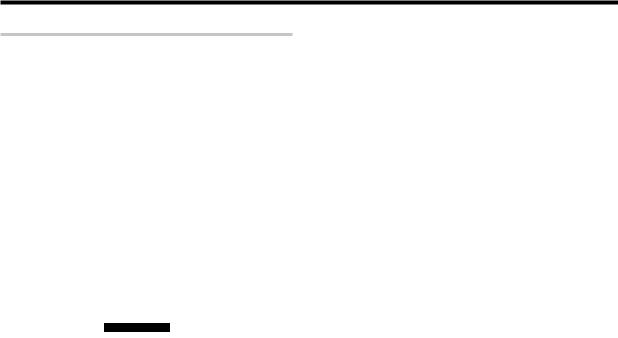
Before applying the power
Special features
True home theater sound
This receiver incorporates a wide variety of surround modes to bring you maximum enjoyment from your video software. Select a surround mode according to your equipment or the software you are going to play and enjoy! §
Dolby Digital and Dolby Digital EX
The DOLBY DIGITAL mode lets you enjoy full digital surround from software processed in the Dolby Digital format. Dolby Digital provides up to 5.1 channels of independent digital audio for better sound quality and more powerful presence than conventional Dolby Surround.
As for Dolby Digital EX, it creates six full-bandwidth output channels from the 5.1 channel sources. This is done using a matrix decoder that derives three surround channels from the two in the original recording. For best results, Dolby Digital EX should be used with movie soundtracks recorded with Dolby Digital Surround EX.
Dolby PRO LOGIC II
DOLBY PRO LOGIC II, whilst totally compatible with its predecessor PRO LOGIC, provides greater advantages in surround sound. It allows the user to enjoy the conventional stereo or Dolby Surround with a convincing “5.1 like” presentation. PRO LOGIC II offers special features for controlling the overall spatial, dimensionality and frontal sound field imaging. PRO LOGIC II produces an impressive surround sound from video software marked and three-dimensional space from music CD. When listening to music, you will be able to enjoy the experience of sheer STEREO surround sound.
SRS Circle Surround II
SRS Circle Surround II™ improves on its predecessor CS-5.1™ resulting in the CS-6.1™ system, enabling you to listen to realistic, multi-channel, surround sound playback from a stereo source or conventional surroundencoded video source. You already enjoy listening to Dolby Digital /DTS multi-channel sound with your multi-speakers. Now you can listen to audio CDs, MDs, Broadcast and Home Theater using your multispeakers. You will discover a new type of sound through SRS Circle Surround II.
DSP surround modes
The DSP (Digital Signal Processor) used for this receiver incorporates a variety of high quality adjustable sound fields, like “ARENA”, “JAZZ CLUB”, “THEATER”, “STADIUM” and “DISCO”. It is compatible with almost any kind of program source.
DVD 6-channel input
If you own a DVD player equipped with 6-channel output, this receiver allows you to obtain the full surround sound impact of DVD source material featuring multi-channel encoding. Since the source signals are digital and each channel is input independently, the resulting ambience is far superior to what can be achieved with conventional surround sound systems.
ACTIVE EQ
ACTIVE EQ mode will produce a more dynamic sound quality in any condition. You can enjoy a more impressive sound effect when ACTIVE EQ is turned on during Dolby Digital and DTS playback.
DTS and DTS-ES
DTS (Digital Theater System) is a 5.1 channel digital audio format that provides five full spectrum channels and one low-frequency (subwoofer) channel for unprecedented clarity, optimum channel seperation and a (wide) dynamic range.
DTS-ES (Extended Surround) presents 6.1 channels surround system with additional Surround Back channel which evolved from the conventional 5.1 channels surround system. DTS-ES format that was recorded in DVD, CD or LD comprises of two modes. DTS-ES Discrete 6.1 produce the discrete surround back which is completely independent and DTS-ES Matrix 6.1 produces the surround back which synthesised within the left and right surround channels using matrix technology. DTS-ES has perfect compatibility with the conventional 5.1 channels surround system. 6.1 channels surround with an additional surround back presents a more natural presence and surround effects by increasing the impression of the sound image from back.
Important:
When a DTS disc is played on a CD, LD or DVD player, noise may be output from the analog output. It is recommended that you connect the digital output of the player to the digital input of this unit.
SPEAKER EQ
SPEAKER EQ function is to adjust the receiver’s audio output characteristics with the speakers’ characteristics which differs depending on the size of the speakers. Especially for the music sound source playback, the reproduced sound becomes more natural when adjusting the output characteristics. When activating the SPEAKER EQ function, you will be able to enjoy a more natural and dynamic sound experience even with small size speakers.
Universal IR (InfraRed) remote control
In addition to the basic receiver, the remote control supplied with this receiver can also operate almost all of your remote controllable audio and video components. Just follow the simple setup procedure to register the components you have connected.
Neo:6
Neo:6 is a new technology which was developed by DTS. It can produce high grade 6 channels surround with an astonishing fidelity from 2 channels content. Neo:6 has 2 mode, "CINEMA" mode is for movie playback and "MUSIC" mode is for music playback.
5 EN
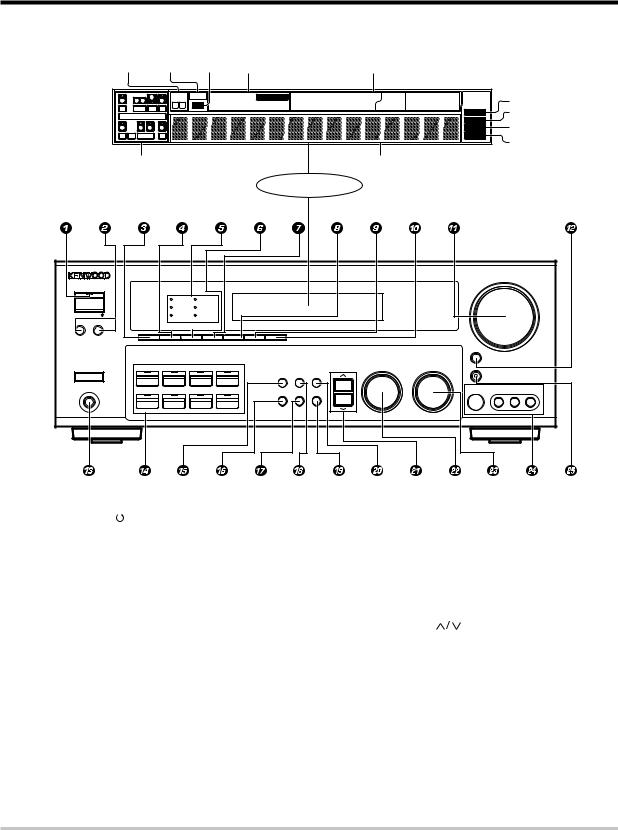
Names and functions of parts
Main unit
Speaker |
MUTE |
CLIP |
Input mode |
Listen mode |
indicators |
indicator |
indicator |
indicators |
indicators |
|
|
|
|
|
SP |
MUTE |
OPTICAL 6CH INPUT |
AUTO DETECT |
|
DTS DOLBY DIGITAL STEREO |
NEO:6 |
AUTO indicator |
||||
|
|
|
|
|
A |
B |
CLIP |
|
|
|
|
MATRIX |
|
|
|
|
L |
|
C |
SW |
R |
COAXIAL |
ANALOG |
96kHzfs |
DSP MODE |
DISCRETE |
PRO LOGIC |
LOUDNESS |
CS II |
MEMORY indicator |
|||
|
|
|
|
|
|
|
|
|
|
|
AUTO |
|||||
|
|
LFE |
|
|
|
|
|
|
|
|
|
|
|
|
||
|
|
|
|
|
|
|
|
|
|
|
|
|
|
MEMORY |
|
|
|
|
|
|
|
|
|
|
|
|
|
|
|
|
|
STEREO indicator |
|
|
|
|
|
|
|
|
|
|
|
|
|
|
|
|
STEREO |
|
SL |
S |
SB |
|
SR |
|
|
|
|
|
|
|
|
|
|
TUNED |
TUNED indicator |
|
|
|
|
|
|
|
|
|
|
|
|
|
|
|
|
|
Speaker selection indicators |
|
Frequency display |
Input channel indicators |
Display |
Input display |
Output channel indicators |
Preset channel display |
|
|
|
Surround mode display |
|
|
|
|
|
|
|
|
|
|
|
VOLUME CONTROL |
|
POWER |
|
|
|
|
|
|
|
|
|
|
|
|
STANDBY |
|
|
|
|
|
|
|
|
|
|
|
|
|
|
DSP |
DOLBY DIGITAL |
|
|
|
|
|
|
|
|
|
|
|
SPEAKER EQ |
DTS |
|
|
|
|
|
|
|
|
|
ON/STANDBY |
|
ACTIVE EQ |
CS II |
|
|
|
|
|
|
|
|
|
A SPEAKERS B |
LOUDNESS SPEAKEREQ ACTIVEEQ |
DSP |
STEREO |
INPUT MODE |
DIMMER |
|
|
|
|
|
||
|
|
|
|
|
|
|||||||
|
|
|
|
|
|
|
|
|
|
DOWN |
|
UP |
|
|
|
|
|
|
|
|
|
|
|
MUTE |
|
|
DVD/6CH |
CD/DVD |
PHONO |
|
TUNER |
|
|
|
MULTI CONTROL |
LISTEN MODE |
|
|
|
|
|
|
|
|
|
|
|
||||
F ULL DIGITA L |
|
|
|
|
|
|
SOUND |
TONE |
SETUP |
|
AV AUX |
|
D E C O D I N G |
|
|
|
|
|
|
|
|
|
|
|
|
PHONES |
VIDEO 1 |
VIDEO 2 |
VIDEO 3 |
MD/TAPE |
|
BAND |
AUTO MEMORY |
S VIDEO |
VIDEO |
L-AUDIO-R |
||
|
|
|
|
|||||||||
|
|
|
|
|
|
|
|
|
|
|||
1 POWER ON/STANDBY |
|
key |
* |
Use to turn the power ON/STANDBY. |
|
||
STANDBY indicator |
|
||
2 A SPEAKERS B keys |
) |
||
Use to turn the A/B speakers on or off. |
|||
3 LOUDNESS key |
¡ |
||
Use to switch the status of LOUDNESS. |
|||
4 SPEAKER EQ key |
¡ |
||
Use to select SPEAKER EQ’s setting.
5Surround LED (lighting-emitting diode) indicators
DSP mode LED indicator ª
Lights when the receiver is in the DSP mode.
SPEAKER EQ mode LED indicator ™
Lights when the receiver is in the SPEAKER
EQ mode. |
|
ACTIVE EQ mode LED indicator |
™ |
Lights when the receiver is in the ACTIVE EQ mode.
DOLBY DIGITAL mode LED indicator
ª
Lights when the receiver is in the Dolby
Digital mode. |
|
DTS mode LED indicator |
ª |
Lights when the receiver is in the DTS mode.
CS II mode LED indicator ª
Lights when the receiver is in the CIRCLE SURROUND II mode.
6 ACTIVE EQ key |
¡ |
Use to select ACTIVE EQ’s setting. |
|
7 DSP key |
ª |
Use to select any of the DSP mode. |
|
8 STEREO key |
º |
Use to switch the listen mode to STEREO. |
|
9 INPUT MODE key |
8 |
Use to switch between the full auto, digital |
|
and analog inputs. |
|
0 DIMMER key |
|
Use to select the REC MODE. |
£ |
Use to adjust the brightness of the display. |
|
|
¤ |
! VOLUME CONTROL knob |
* |
@ MUTE key |
¡ |
Use to temporarily mute the sound. |
|
# PHONES jack |
¡ |
Use for headphone listening. |
|
$ Input Selector keys |
¡ |
(DVD/6CH, CD/DVD, PHONO, TUNER, |
|
VIDEO 1, VIDEO 2, VIDEO 3, MD/TAPE) |
|
Use to select input sources. |
|
% SOUND key |
º |
Use to adjust the sound quality and the |
|
ambience effects. |
|
^ BAND key |
¢ |
Use to select the broadcast band.
& AUTO key |
¢ |
|
|
Use to select the auto or manual tuning |
|
|
mode. |
|
* TONE key |
¡ |
|
|
Use to switch the status of TONE control. |
|
( MEMORY key |
¢ |
|
|
Use to store radio stations in the preset |
|
|
memory. |
|
) SETUP key |
* |
|
|
Use to select the speakers' settings etc. |
|
¡ |
keys |
* |
|
Use for selection adjustments during sound, |
|
|
set up and preset channel functions. |
|
™ MULTI CONTROL knob |
* |
|
|
Use to control a variety of settings. |
|
£ LISTEN MODE knob |
ª |
|
|
Use to select the listening mode. |
|
¢ AV AUX (S VIDEO, VIDEO, L-AUDIO-R) |
||
|
jacks |
^ |
∞ AV AUX key |
^ |
|
Use to switch the input to AV AUX.
Standby mode
While the standby indicator is lit, a small amount of power is supplied to the system to back up the memory. This is called standby mode. Under the condition, the system can be turned ON by remote control unit.
6 EN
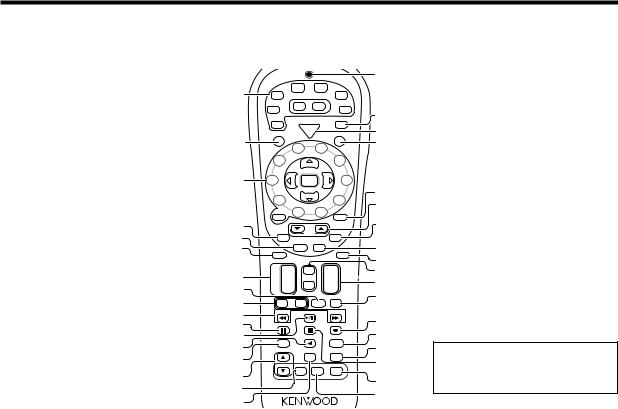
Names and functions of parts
Remote control unit
This remote control unit can be use not only for Kenwood products but also for other non-Kenwood products by setting the appropriate manufacturer’s setup codes. fi
*
|
|
TUNER |
DVD |
1 |
|
6CH |
|
|
|
||
VID1 |
|
CD |
|
|
DVD |
2
VID2 |
VID3 |
AV AUX |
|
MD |
|
|
|
TAPE |
|
|
|
|
|
|
PHONO |
|
POWER |
|
TV |
|
|
|
|
|
C Po |
RCVR |
|
Po |
|
|
|
|||
R |
w |
T |
V |
we |
e |
r |
|||
S |
r |
|
|
|
|
4 |
5 |
|
|
3 |
|
Multi |
|
6 |
|
|
|
|
|
(
)
¡
1Source keys(MD/TAPE, CD/DVD,DVD/6CH, TUNER, VID1, VID2, VID3, AV AUX, PHONO)
When press and hold for more than 3 seconds, they are used to select the registered components.
¡
Input Selector keys (MD/TAPE, CD/DVD, DVD/ 6CH, TUNER,VID1,VID2, VID3,AVAUX, PHONO)
When press and release in less than 3 seconds, they are used to select the input sources. ‹
2SRC ( source) Power key
Use to turn the other source components on or off.
3 Numeric keys |
‹ |
Provide functions identical to those of the |
|
original remote control supplied with the |
|
component you are controlling. |
|
Multi (multi control) %/fi keys |
* |
Use to control a variety of settings. |
|
Use to operate other components. |
|
P.Call @/# keys |
∞ |
Use for selection adjustments during sound, set up and preset channel functions.
Enter key
Use to operate other components.
4Return key
Use to operate the DVD component.
Exit key
Use to operate other components.
5Disc Skip key
If CD is selected as the input source, this key functions as the multi-CD player disc skip key.
LAST/A/B key
If TAPE is selected as the input source, this is A and B deck of a double cassette deck.
Use to operate other components.
6Disc Sel. key
Use to operate other components.
Input Sel. key
Use to operate other components.
7 CH +/– keys
Use to select the channels.
¢ / 4 keys
If CD, MD and DVD is selected as the input source, these keys function as skip keys.
8TV Input key
Use when in TV operation.
3 |
2 |
|
P. Call |
|
Enter |
|
Call .P |
7 |
|
|
|
1 |
|
|
|
Multi |
|
8 |
|
™ |
|
|
|
|
|
|
|
|
£ |
|||
|
|
|
|
0 |
|
|
9 |
|
|
|
|
+ 10 |
|
|
|
+ 100 |
|
||||
4 |
|
|
|
|
|
¢ |
||||
|
|
|
|
|
|
|
TV Mute |
|||
5 |
|
|
|
|
|
Page |
|
|
|
|
Return |
|
|
|
|
|
OSD |
|
|
||
6 |
|
Exit |
LAST/A/B |
|
Guide |
|
∞ |
|||
|
Disc Skip Menu |
|
||||||||
|
|
|
|
|||||||
|
Disc Sel. |
|
|
|
|
|
Mute |
§ |
||
|
Input Sel. |
|
|
|
|
|
+ |
|
||
|
¢ |
+ |
|
|
|
Tone |
|
|
¶ |
|
7 |
|
|
|
|
|
|
|
|
|
|
|
CH |
|
|
|
|
VOL |
|
• |
||
|
|
|
|
|
|
|
||||
8 |
4 |
– |
|
|
Sound |
|
– |
|
||
|
|
|
|
|
|
ª |
||||
|
|
TV |
|
|
|
|
Bass |
|
||
|
|
|
|
TV Input |
|
|
||||
9 |
|
– VOL |
+ |
|
Boost |
|
|
|||
|
|
|
|
|
|
|||||
0 |
Tune – |
|
|
|
Band |
|
Tune + |
|
|
|
! |
Dimmer |
|
|
|
Auto |
|
Top Menu |
|
º |
|
@ |
|
Input |
|
|
Info/Flip |
|
Setup |
|
⁄ |
|
# |
|
|
|
|
|
|
Loudness |
|
|
|
|
Mode |
|
|
|
|
|
|
¤ |
||
$ |
|
|
|
|
|
Active |
|
Remote |
|
|
|
|
|
|
|
|
EQ |
|
Setup |
|
‹ |
|
Listen Mode |
DSP |
|
|
|
|
||||
|
|
|
|
Stereo |
Speaker |
|
|
|||
% |
|
|
|
Mode |
EQ |
|
|
|||
|
|
|
|
|
|
|
||||
|
|
|
|
|
|
|
|
|
› |
|
|
|
|
|
|
|
|
|
|
|
|
^ |
fi |
|
& |
||
|
||
9 TV VOL +/– keys |
|
|
Use to adjust the TV’s volume. |
|
01/¡ keys
If CD, MD or Tape is selected as the input source, this key functions as search keys.
Tune –/+ key
Use to operate the tuner mode.
!8 key
Use to operate other components.
Dimmer key ¤
Use to adjust the brightness of the display.
@3/8 key
If CD is selected as the input source, this key functions as the play/pause key.
If MD or TAPE key is selected as input source,
this key functions as the play key.
Band key ¢
Use to select the broadcast band.
#2 key
If Tape is selected, this key functions as reverse play key.
Info/Flip key |
|
Use to operate other components. |
|
$ Input Mode key |
8 |
Use to switch between the full auto, digital |
|
and analog inputs. |
|
% Listen Mode 5/∞ keys |
ª |
Use to select the listening mode. |
|
^ DSP Mode key |
ª |
Use to select any of the DSP mode. |
|
& Active EQ key |
¡ |
Use to select ACTIVE EQ’s setting.
* LED (lighting-emitting diode) indicator
Blinkstoshowthatsignalsarebeingtransmitted.
(TV key
Use to select the TV equipment.
) POWER RCVR ( receiver) key |
* |
Use to turn the receiver on or off. |
|
¡ TV Power key |
|
Use to turn the TV on or off. |
|
™+100 key
Use to select the disc number with the multiCD player.
TV mute key
Use to temporarily mute the TV sound.
If the name of a function is different on the receiver and on the remote control, the name of the remote control key in this manual is indicated in parentheses.
£ Page 5/∞ key
Use to operate other components.
¢OSD (on screen display) key
Use to operate the DVD component.
Guide key
Use to operate other components. |
|
∞ Menu key |
|
Use to operate other components. |
|
§ Mute key |
¡ |
Use to temporarily mute the sound. |
|
¶ Tone key |
¡ |
Use to switch the status of TONE control. |
|
Sound key |
º |
Use to adjust the sound quality and the |
|
ambience effects. |
|
• VOL +/– keys |
¡ |
Use to adjust the receiver’s volume. |
|
ª Bass Boost key |
¡ |
Use to select the maximum adjustment setting for the low frequency range.
º÷ key
If VCR is selected, this key functions as record key when it pressed twice sequentially. When in MD or Tape is selected, this key functions as record key.
Top Menu key |
|
Use to operate the DVD component. |
|
Setup key |
* |
Use to select the speakers’ settings etc. |
|
⁄ Loudness key |
¡ |
Use to switch the status of LOUDNESS.
¤Remote Setup key
Use to register other components.
‹7 key
If CD, MD, or TAPE is selected as the input
source, this key functions as the stop key.
Auto key |
¢ |
Use to select the auto or manual tuning |
|
mode. |
|
› Speaker EQ key |
¡ |
Use to select SPEAKER EQ’s setting. |
|
fi Stereo key |
º |
Use to switch the listen mode to STEREO.
7 EN
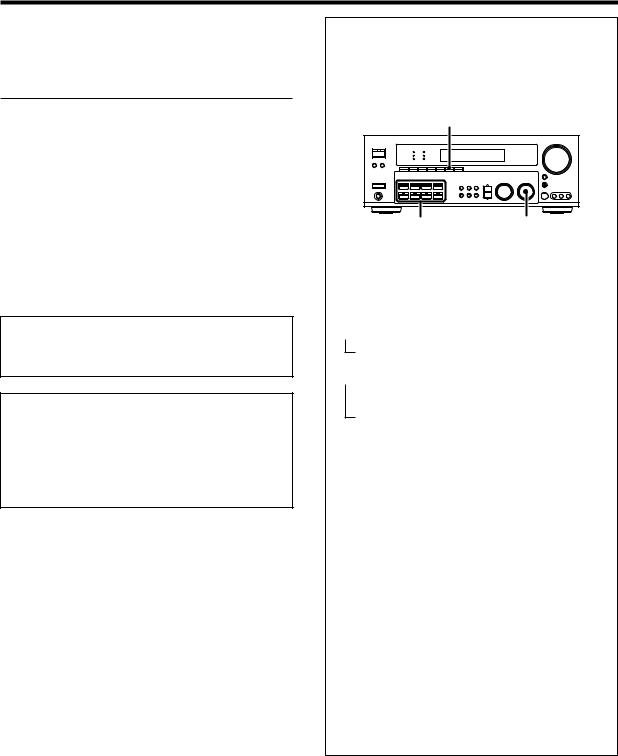
Setting up the system
Make connections as shown in the following pages. When connecting the related system components, be sure to refer to the instruction manuals supplied with the components you are connecting.
Do not connect the power cord to a wall outlet until all connections are completed.
Notes
1.Be sure to insert all connection cords securely. If their connections are imperfect, sound may not be produced or there will be noise inference.
2.Be sure to remove the power cord from the AC outlet before plugging or unplugging any connection cords. Plugging/unplugging connection cords without disconnecting the power cord can cause malfunctions and may damage the unit.
3.Do not connect power cords from components whose power consumption is larger than what is indicated on the AC outlet at the rear of this unit.
Analog connections
Audio connections are made using RCA pin cords. These cables transfer stereo audio signal in an “analog” form. This means the audio signal corresponds to the actual audio of two channels. These cables usually have 2 plugs on each end, one red for the right channel and one white for the left channel. These cables are usually packed together with the source unit, or are available at your local electronics retailer.
Microcomputer malfunction
If operation is not possible or an erroneous display appears, even though all connections have been made properly, reset the microcomputer referring to “In case of difficulty”. w
CAUTION
Be sure to adhere to the following, or proper ventilation will be blocked causing damage or fire hazard.
•Do not place any objects impairing heat radiation onto the top of the unit.
•Leave some space around the unit (from the largest outside dimension including projection) equal to or greater than, shown below.
Top panel : 50 cm Side panel : 10 cm Back panel : 10 cm
Input mode settings
CD/DVD, VIDEO 2, VIDEO 3 and DVD/6CH inputs each include jacks for digital audio input and analog audio input.
The initial factory settings for audio signal playback for CD/DVD,
DVD/6CH, VIDEO 2 and VIDEO 3 are full auto.
After completing connections and turning on the receiver, follow the steps below.
INPUT MODE
Input Selector |
LISTEN MODE |
1Use the Input Selector keys to select CD/DVD, VIDEO 2, VIDEO 3 or DVD/6CH.
2Press the INPUT MODE key.
Each press switches the setting as follows:
In DTS play mode
 1 FULL AUTO (digital input, analog input) 2 DIGITAL MANUAL (digital input)
1 FULL AUTO (digital input, analog input) 2 DIGITAL MANUAL (digital input)
In CD/DVD, VIDEO 2, VIDEO 3 or DVD/6CH play mode
 1 FULL AUTO (digital input, analog input) 2 DIGITAL MANUAL (digital input)
1 FULL AUTO (digital input, analog input) 2 DIGITAL MANUAL (digital input)
3 6CH INPUT (DVD/6CH input)
4 ANALOG (analog input)
Digital input:
Select this setting to play digital signals from a DVD, CD, or LD player.
Analog input:
Select this setting to play analog signals from a cassette deck, VCR, or record player.
Auto detect:
In “FULL AUTO” mode (AUTO DETECT indicator light up), the receiver detects the digital or analog input signals automatically. Priority is given to digital signal during input mode selection. The receiver will select the input mode and listening mode automatically during playback to match the type of input signal (Dolby Digital, PCM, DTS) and the speaker setting. The OPTICAL and COAXIAL indicator on the display will light up when digital signal is detected. If the input signal is analog, the ANALOG indicator will light up.
To keep the receiver set to the currently selected listening mode, use the INPUT MODE key to select “DIGITAL MANUAL” (manual sound). However, even when this setting is selected, there may be cases in which the listening mode is selected automatically to match a Dolby Digital source signal depending on the combination of listening mode and source signal.
At DIGITAL MANUAL, if the audio reproduction stops in the middle due to change in the input signals, etc. press the LISTEN MODE Knob.
If the INPUT MODE key is pressed quickly, sound may not be produced. Press the INPUT MODE key again.
8 EN
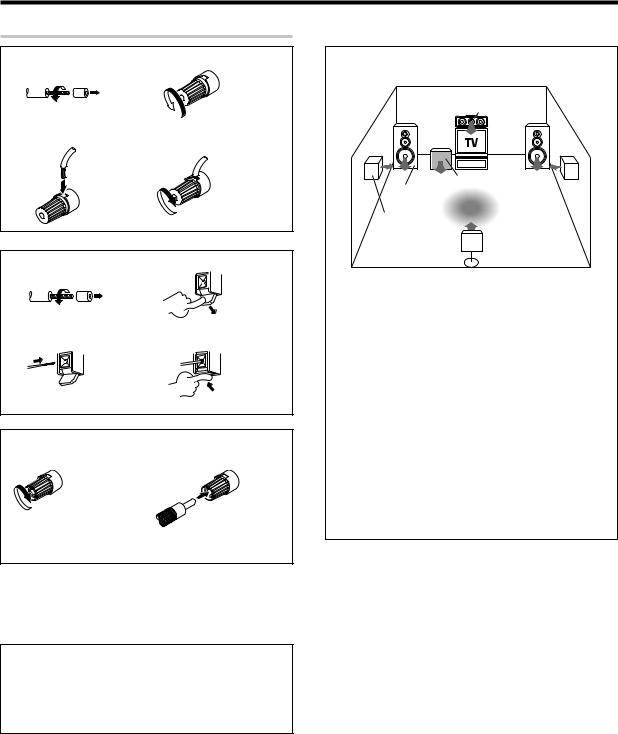
Setting up the system
Connecting the terminals
1 Strip coating. |
2 Loosen. |
||
|
|
|
|
3 Insert. |
4 Secure. |
1 Strip coating. |
2 Push the lever. |
|||
|
|
|
|
|
|
|
|
|
|
|
|
|
|
|
3 Insert the cord. |
4 Return the lever. |
Connection of banana plugs
1 Secure. |
2 Insert. |
•Sound will not be heard if the speaker terminal is not fully secured.
•Never short circuit the + and – speaker cords.
•If the left and right speakers are connected inversely or the speaker cords are connected with reversed polarity, the sound will be unnatural with ambiguous acoustic imaging. Be sure to connect the speakers correctly.
Speaker impedance
After confirming the speaker impedance indications printed on the rear panel of the receiver, connect speakers with matching impedance ratings. Using speakers with a rated impedance other than that indicated on the rear panel of the receiver could result in malfunctions or damage to the speakers or receiver.
Speaker placement
Center speaker
Front speakers |
Subwoofer |
|
|
(L,R) |
Listening |
Surround |
position |
|
|
speakers |
|
(L,R) |
|
 Surround
Surround
back speaker
Front (left and right) speakers
Place at the front left and right of the listening position. Front speakers are required for all surround modes.
Center speaker
Place front and center. This speaker stabilizes the sound image and helps recreate sound motion. Required for surround playback.
Surround (left and right) speakers
Place at the direct left and right, or slightly behind, the listening position at even heights, approximately 1 meter above the ears of the listeners. These speakers recreate sound motion and atmosphere. Required for surround playback.
Subwoofer
Reproduces powerful deep bass sounds.
Surround back speaker
Place the speaker directly at the rear of the listening position. The optimum position depends mainly on the room condition.
•Although the ideal surround system consists of all the speakers listed above, if you don't have a center speaker or a subwoofer, you
can divide those signals between the available speakers in the speaker settings steps to obtain the best possible surround reproduction from the speakers you have available. *
9 EN

Setting up the system
Connecting audio components
SYSTEM CONTROL jacks &
To AC wall outlet |
|
IN |
IN |
REC OUT PLAY IN |
|
L |
|
|
|
R |
|
|
GND |
PHONO |
CD/DVD |
MD/TAPE |
OUT
Cassette deck or
MD recorder
IN
OUT
CD or DVD player
Moving coil (MC) cartridge record player cannot be used directly from the receiver unit. It can only
be used when another equalizer
amplifier is connected.
OUT
Record player
10 EN
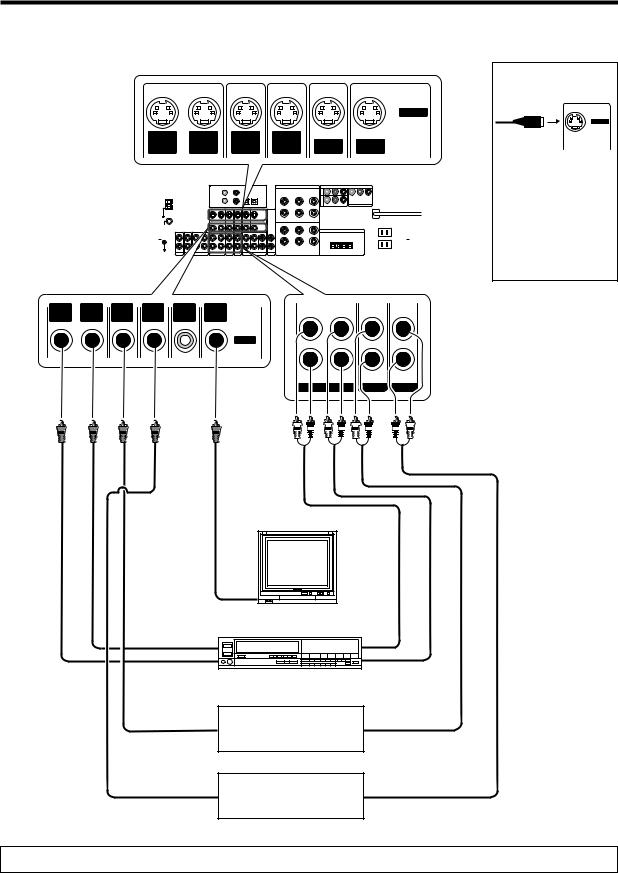
Setting up the system
Connecting video components
S Video jacks
S VIDEO
S VIDEO |
S VIDEO |
S VIDEO |
S VIDEO |
|
|
|
|
|
|
|||||
|
OUT |
IN |
IN |
IN |
DVD |
MONITOR |
||||||||
|
VIDEO |
VIDEO |
VIDEO |
VIDEO |
IN |
OUT |
||||||||
|
|
|
|
|
|
|
|
|
|
|
|
|
|
|
|
|
|
|
|
|
|
|
|
|
|
|
|
|
|
|
|
|
|
|
|
|
|
|
|
|
|
|
|
|
|
|
|
|
|
|
|
|
|
|
|
|
|
|
|
|
|
|
|
|
|
|
|
|
|
|
|
|
|
|
|
|
|
|
|
|
|
|
|
|
|
|
|
|
|
|
|
|
|
|
|
|
|
|
|
|
|
|
|
|
|
|
|
|
|
|
|
|
|
|
|
|
|
|
|
|
|
|
|
|
|
|
|
|
|
|
|
|
|
|
|
|
|
|
|
|
|
|
|
|
|
|
|
|
|
|
|
|
|
|
|
|
|
|
|
|
|
|
|
|
OUT |
IN |
IN |
IN |
DVD |
MONITOR |
REC OUT PLAY IN |
PLAY IN |
PLAY IN |
VIDEO |
VIDEO |
VIDEO |
VIDEO |
IN |
OUT |
|
|
|
|
|
|
|
|
|
VIDEO |
|
|
|
|
|
|
|
|
VIDEO 1 |
VIDEO 2 |
VIDEO 3 |
|
Monitor TV |
|
VIDEO |
|
IN |
Video |
Video inputs |
IN/OUT |
(Yellow RCA pin cords) |
Video deck |
IN |
OUT |
|
IN |
OUT |
Video inputs and outputs |
Audio inputs |
(Yellow RCA pin cords) |
and outputs |
DVD player or LD player |
|
OUT |
OUT |
DVD player or LD player |
|
OUT |
OUT |
About the S VIDEO jacks
S VIDEO
Use the S VIDEO jacks to make connections to video components with S VIDEO IN/OUT jacks.
•If you use the S VIDEO jacks to connect your video playback components, be sure to use the S VIDEO jacks when connecting your monitor and video recording components.
Audio
IN/OUT
A video component with digital audio outputs should be connected to the VIDEO 2 or VIDEO 3 jacks.
11 EN
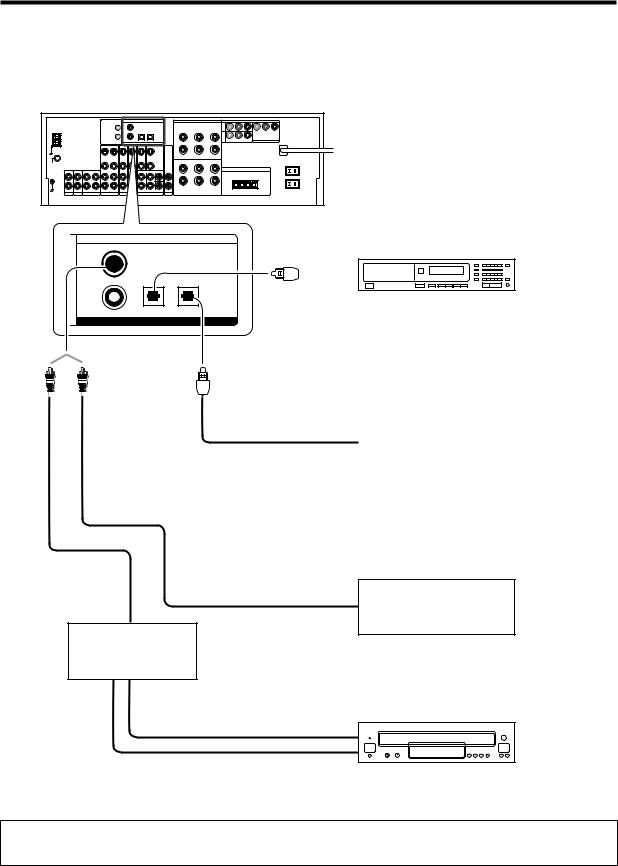
Setting up the system
Digital connections
The digital in jacks can accept DTS, Dolby Digital, or PCM signals. Connect components capable of outputting DTS, Dolby Digital, or standard PCM (CD)
format digital signals. |
|
If you have connected any digital components to the receiver, be sure to read the “Input mode settings” section carefully. |
8 |
COAXIAL OPTICAL OPTICAL
VIDEO 2
DVD/
6CH
CD/DVD |
VIDEO 3 |
DIGITAL IN
OPTICAL DIGITAL OUT (AUDIO)
Optical
fiber cable
CD or DVD player
|
|
OPTICAL DIGITAL OUT (AUDIO) |
|
Optical fiber cable |
|
Component with DTS, |
|
|
|
Dolby Digital, or PCM |
|
|
|
OPTICAL DIGITAL OUT |
|
|
|
|
|
|
Connect the video signal and digital |
||
|
audio signals to the VIDEO 3 jacks. |
||
|
(See “Connecting video components”.) |
||
|
! |
||
COAXIAL DIGITAL OUT (AUDIO)
RF digital demodulator (DEM-9991D) (sold separately)
COAXIAL DIGITAL OUT (AUDIO)
Component with DTS,
Dolby Digital, or PCM
COAXIAL DIGITAL OUT
Connect the video signal and analog audio signals to the VIDEO 2 jacks. (See “Connecting video components”.)
!
DOLBY DIGITAL RF
OUT (AUDIO)
PCM OUT
LD player
To connect an LD player with a DIGITAL RF OUT, connect the LD player to the KENWOOD RF digital demodulator (DEM-9991D). Next, connect the DIGITAL OUT jacks of the demodulator to the DIGITAL IN jacks of the receiver.
Connect the video signal and analog audio signals to the VIDEO 2 or VIDEO 3 jacks. (See “Connecting video components”.)
12 EN
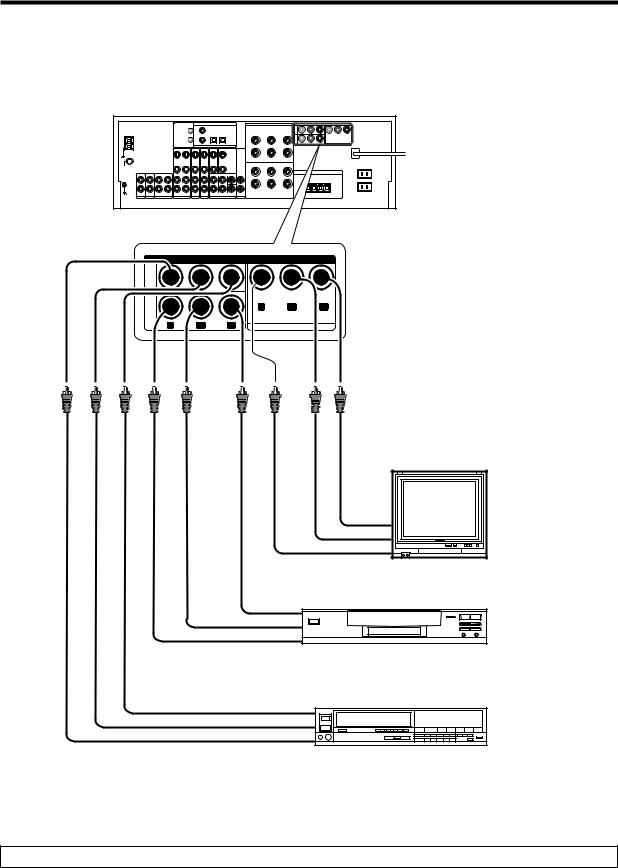
Setting up the system
Connecting video components (COMPONENT VIDEO)
If you have connected the receiver to a video component with COMPONENT jacks, you can get a better picture quality than by connecting to the S-VIDEO jacks.
COMPONENT VIDEO
VIDEO 3 IN
DVD |
|
Y |
CB |
CR |
IN |
|
|||
|
|
|
|
|
Y |
CB |
CR |
MONITOR OUT |
|
|
Monitor TV |
|
(with component jacks) |
|
CR IN |
|
CB IN |
|
Y IN |
CR OUT |
DVD player (with component jacks) |
CB OUT |
|
Y OUT |
• Connect to the VIDEO cord. |
|
Video Recorder, DVD Recorder, |
|
Satellite Cable Tuner & Game |
CR OUT Player (with component jacks)
CB OUT
Y OUT
When connecting the TV to the COMPONENT jacks, be sure to connect all the other components to the COMPONENT jacks.
13 EN
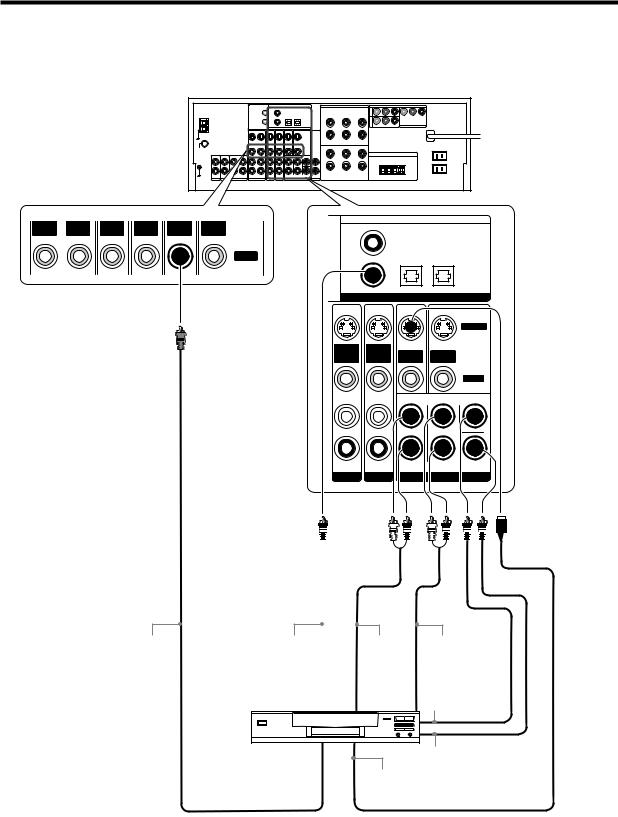
Setting up the system
Connecting a DVD player (6-channel input)
If you have connected a DVD player to the receiver with digital connection, be sure to read the “Input mode settings” section carefully. |
8 |
COAXIAL |
OPTICAL |
OPTICAL |
OUT |
IN |
IN |
IN |
DVD |
MONITOR |
|
CD/DVD |
VIDEO 3 |
VIDEO |
VIDEO |
VIDEO |
VIDEO |
IN |
OUT |
|
||
|
|
|
||||||
|
|
|
|
|
VIDEO |
|
|
|
|
|
|
|
|
2 |
|
|
|
|
|
|
|
|
VIDEO |
|
|
|
|
|
|
|
|
DVD/ |
|
|
|
|
|
|
|
|
6CH |
|
|
|
|
|
|
|
|
|
|
DIGITAL IN |
|
|
|
|
|
|
|
|
|
S VIDEO |
|
|
|
|
|
S VIDEO |
S VIDEO |
|
|
|
|
|
|
|
IN |
IN |
DVD |
MONITOR |
|
|
|
|
|
VIDEO |
VIDEO |
IN |
OUT |
|
|
|
|
|
|
|
|
VIDEO |
|
|
|
|
|
PLAY IN |
PLAY IN |
|
CENTER |
|
FRONT SURROUND SUB WOOFER |
VIDEO 2 VIDEO 3 |
DVD/6CH INPUT |
VIDEO OUT |
COAXIAL |
FRONT |
SURROUND |
(Yellow RCA |
DIGITAL OUT |
OUT L/R |
OUT L/R |
pin cord) |
(AUDIO) |
|
|
|
DVD player |
|
CENTER |
|
|
OUT |
|
|
|
|
SUBWOOFER |
|
|
|
OUT |
|
|
S VIDEO |
|
|
|
OUT |
|
|
|
|
S VIDEO cord |
14 EN
